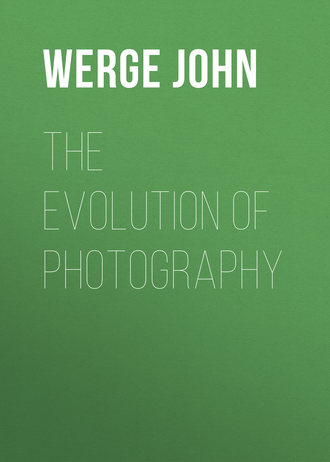 полная версия
полная версияThe Evolution of Photography
How to Point a Pencil.—Rub the pencil to a point in the groove of a corundum file. This is a better and cheaper pointer than a Yankee pencil-sharpener, and it puts a finer point to a blacklead pencil than anything else I know. Retouchers, try it.
How to Ease a Tight Stopper.—There is nothing more annoying in the practice of photography than to take up a bottle and find the stopper fixed. In many instances the bottle is broken and time wasted in trying to remove the fixed stopper. When such an obstinate stopper gets into your hands, run a little glycerine round the top of the bottle. Set the bottle down, and in a few minutes the stopper will be free. Prevention is better than cure. Keep a little glycerine on all your stoppers. Glycerine agrees with every chemical in photographic use, and prevents stoppers and bottles coming to grief. In a thousand and one ways a little glycerine is beyond all price.
How to Prepare Albumenized Prints for Colouring.—Pour over them a little matt varnish. This removes the greasiness, and gives a fine tooth and ivory-like surface for the artist to work upon.
How to Remove Silver Stains from the White Ground of a Vignette.—Touch it with a solution of cyanide of potassium, and wash off immediately. The other parts of the picture will not be injured.
How to Stipple a Window White or Yellow.—For white, mix a little dextrine and kaolin in water. Dab the mixture on the glass with a piece of cotton. For the purpose of obscuration that is quite enough; but if sightliness be essential, finish by stippling with the ends of a hog’s-hair brush. For yellow, mix a little dextrine and deep orange chrome in powder together in water, and apply it to the window in the same manner. Dabbing once or twice with a piece of cotton will exclude white light and make a luminous dark room. The same mixture makes an excellent backing for dry plates to prevent halation.
LIGHTS AND LIGHTING
A great deal has been written and said about lights and lighting—a great deal too much; yet more must be said and written.
Light is to the photographer what the sickle is to the shearer—a good reaper can cut well with an indifferent sickle, but an indifferent reaper never gets a good sickle in his hand. A good photographer, who also understands light and shade, can produce good pictures in an ordinary studio. It is the indifferent photographer who runs after “fancy lights,” and is, like a benighted traveller in pursuit of a will-o’-the-wisp, eventually left floundering in a bog. It is folly to construct powerful concentrators if powerful reflectors have to be employed to counteract their defects. If a limited amount of diffused light be absolutely necessary it is best to retain it and use it in its simplest and least expensive form.
When I commenced photography glass houses were scarcer in England than comets in the heavens, and the few that were in existence were all constructed on false principles. It was not until I visited America that I saw a properly-constructed studio. The Americans were, and are, prone to give stupid names to sensible things; and the names they gave to their studios were no exceptions. This, that, and the other photographer advertised his “mammoth skylight.” I went to sit, see, and be satisfied that their mode of lighting was very superior to ours. I was convinced instanter that the perpendicular sides and sloping roofs of our miserable little hothouses were mistakes and things to be abhorred, while their spacious rooms and “mammoth skylights” were things to be admired and adopted.
In one of these rooms, and almost without blinds or reflectors, the sitter could be “worked” on a semi-circle or half oval, and “lighted” either in front or on either side at pleasure, and with the greatest facility. I determined, there and then, to build my next studio on similar principles; but until recently I have had no opportunity of carrying out my intentions. To get what I required and to make the best of my situation I had to “fence and fiddle” the district surveyor: but I gained my point, and the victory was worth the foils and the fiddlestick.
My studio can be lighted from either side; but the “light of lights” is the north one, and that is a large fixed window 11 by 9 feet with a single slope of two and a half feet in the height; that is, two and a half feet out of the perpendicular at the top, with no other top light and no perpendicular side light. With this light I do all ordinary work. I can work round the light from one side of the room to the other, as under a mammoth skylight, without using either blind or reflector. If I want Rembrandt effects I have only to open a shutter on the south side, and let in subdued sunlight. That at once becomes the dominant light, and the north light illumines the shadows. The bottom of the north light is three feet from the floor.
The advantages of this form of studio are these. It is cool, because no more light is admitted than is absolutely necessary. It is neat, because no rag-like curtains are hanging about. It is clean, because there is nothing to collect dirt. It is dry, because the pitch of the roof renders leakage impossible. It is pleasant to the sitter, because of these desirabilities, and that the light is not distressing. It is agreeable to the operator, because the work is easy and everything is comfortable.



